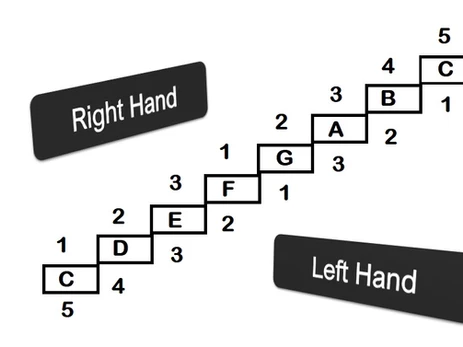Uncategorized
A Major scales piano – How to play it?
Piano major scales, A major scale piano:
Did you ever wonder what is A Major Scale? How can you learn, exercise and master them? In this article, you will find the answer to your questions!
INTRODUCTION:
The importance of practising piano scales
Studying chords on major scales (and all scales actually, but major scales are usually the ones we start with) is the most important and mandatory in piano practice. Mastering the execution of all major scales and minor ones of the most different types is essential for a musician, whatever the instrument. It is through this succession of notes that fundamental techniques are developed to improve the sound and agility of every pianist. And, as they are the raw material for most of the composition for the instrument, the study of the scales helps to understand the harmonic-melodic structures and gives the musician elements for improvisation.
Not recognising this importance and all the benefits that the study of the minor and major scales on piano can bring, most students underestimate this practice, considering it repetitive and lacking in musicality. This apparent “waste of time” makes them look at other studies that give them more pleasure, such as repertoire pieces. What they often do not know is that since the pre-baroque period, through periods such as classicism and romanticism, scales played a fundamental role both in composition and in improvisation or the search for the perfect technique. Let’s go now through A Major scale piano topic.
MAJOR SCALES PATTERNS AND FINGERING
What is a major scale?
If you want to play chords in all major scales, the first thing you have to learn are intervals. Intervals are distances between keys. To determine the scales, we only need to know two: tones and semitones (whole tones and halftones in American English).
The example below shows how a semitone goes from one key to another without any key in the middle. For example, E to F is a semitone, B to C and F to F# as well.
The tones comprise two semitones, so, for example, D to E is a tone, E to F# or F# to G#.
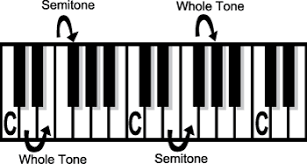
With this new information, we can present the formula of all major scales:
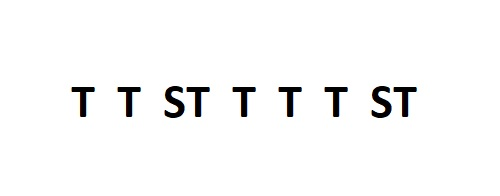
Let’s see an example for notes and chords in c,, major scale on piano:
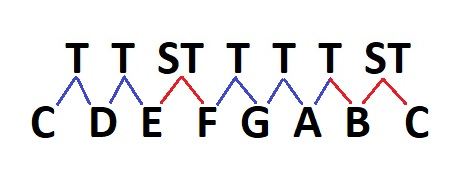
Now, let us add the finger numbers in a one-octave scale (this means that we are just going to play eight notes).
FINGER NUMBERS for the RIGHT HAND:

The first thing we notice is the numbers on top of the keys. In the case of the piano, we name our fingers with numbers. Let us look at the graph below:
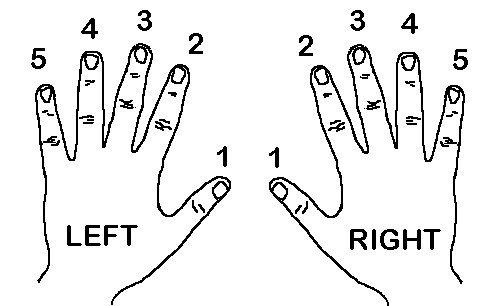
If you see the graph above, you will notice that the finger 1 plays at the beginning and as well the F note. This means we must execute “the passage of the thumb.”
What Does It Mean?
It means that to play this major scale; it is necessary to pass our thumb below our wrist to get to, for example in the case of the right hand, from the third finger playing the E to the F played by the first finger again.
FINGER NUMBERS for the LEFT HAND:
Something similar happens with the left hand, in which the third finger goes over the first finger to play the next note, A:

Do not forget that we play the same notes but with different fingers, depending on the hand. Here is how it looks when we compare the fingering of the right and left hands:
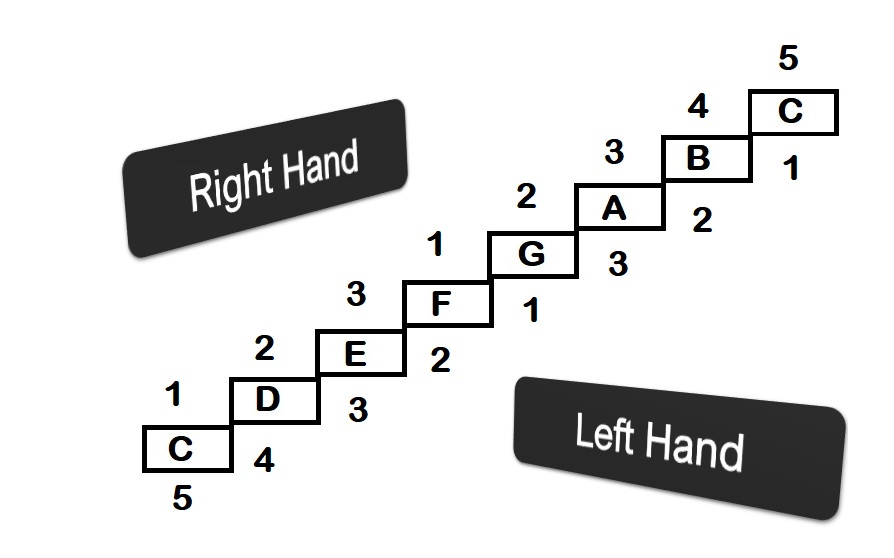
MAJOR SCALES NOTES ON THE STAFF
After learning the structure or “formula”, the notes and fingers, the next step is to see how we write the notes on the ,,music sheet or “Staff”:
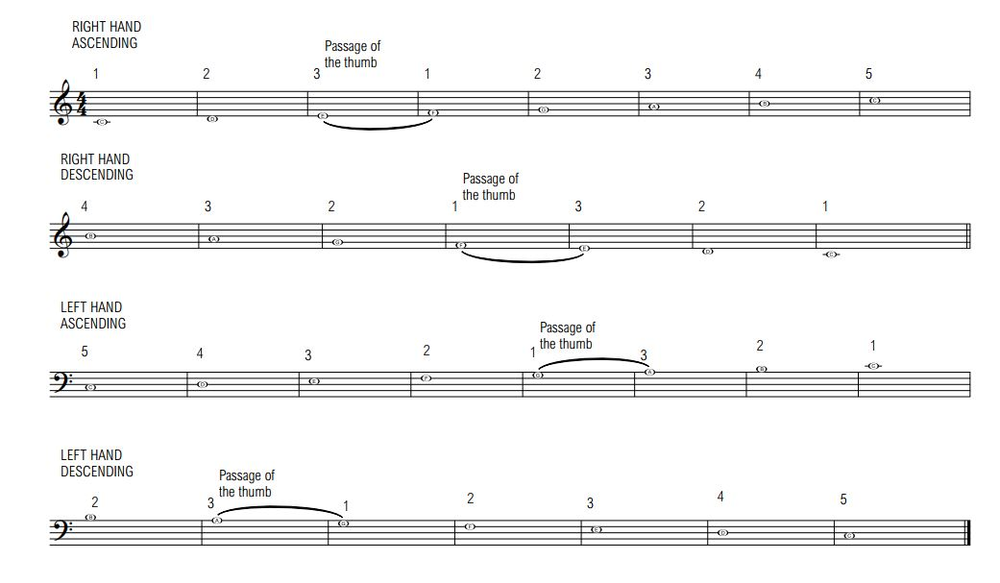
VIDEO TUTORIALS – STEP BY STEP
RIGHT HAND – ONE OCTAVE – ASCENDING AND DESCENDING
https://www.youtube.com/watch?v=LCiq8sFZx0o
LEFT HAND – ONE OCTAVE- ASCENDING AND DESCENDING
https://www.youtube.com/watch?v=yLOpzVB91qw&feature=youtu.be
HANDS TOGETHER – ONE OCTAVE – ASCENDING AND DESCENDING
https://www.youtube.com/watch?v=I4qoW2bkFtg&feature=youtu.be
RIGHT HAND – TWO OCTAVES – ASCENDING AND DESCENDING
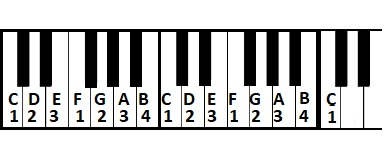
LEFT HAND – TWO OCTAVES – ASCENDING AND DESCENDING
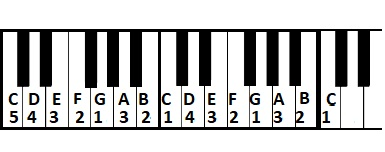
HANDS TOGETHER – TWO OCTAVES – ASCENDING AND DESCENDING
https://www.youtube.com/watch?v=F_3UIDRMnyo&feature=youtu.be
TECHNICAL TIPS FROM THE SCARAMUZZA TECHNIQUE TO PLAY THE SCALES:
1. Elbow should always be loose. Relax them.
2. Keep your wrist always straight and slightly higher than the level of the keyboard
3. The thumb should be always relatively curved inwards
4. The hand should not bounce on each note.
5. We should keep a certain distance from the keys.
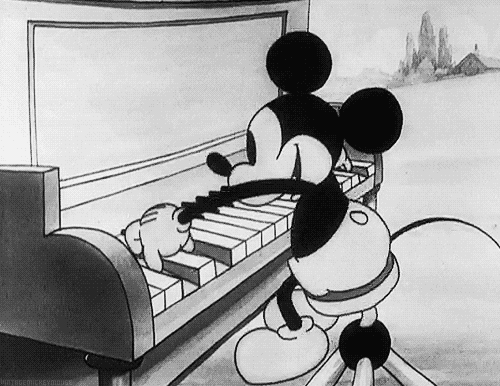
e major scale chords / f major scale chords
8 notes piano
Learn all about Minor Scales with our post on WKMT Blog too!
https://www.piano-composer-teacher-london.co.uk/post/minor-scales
#keyboardscale #majorscales

